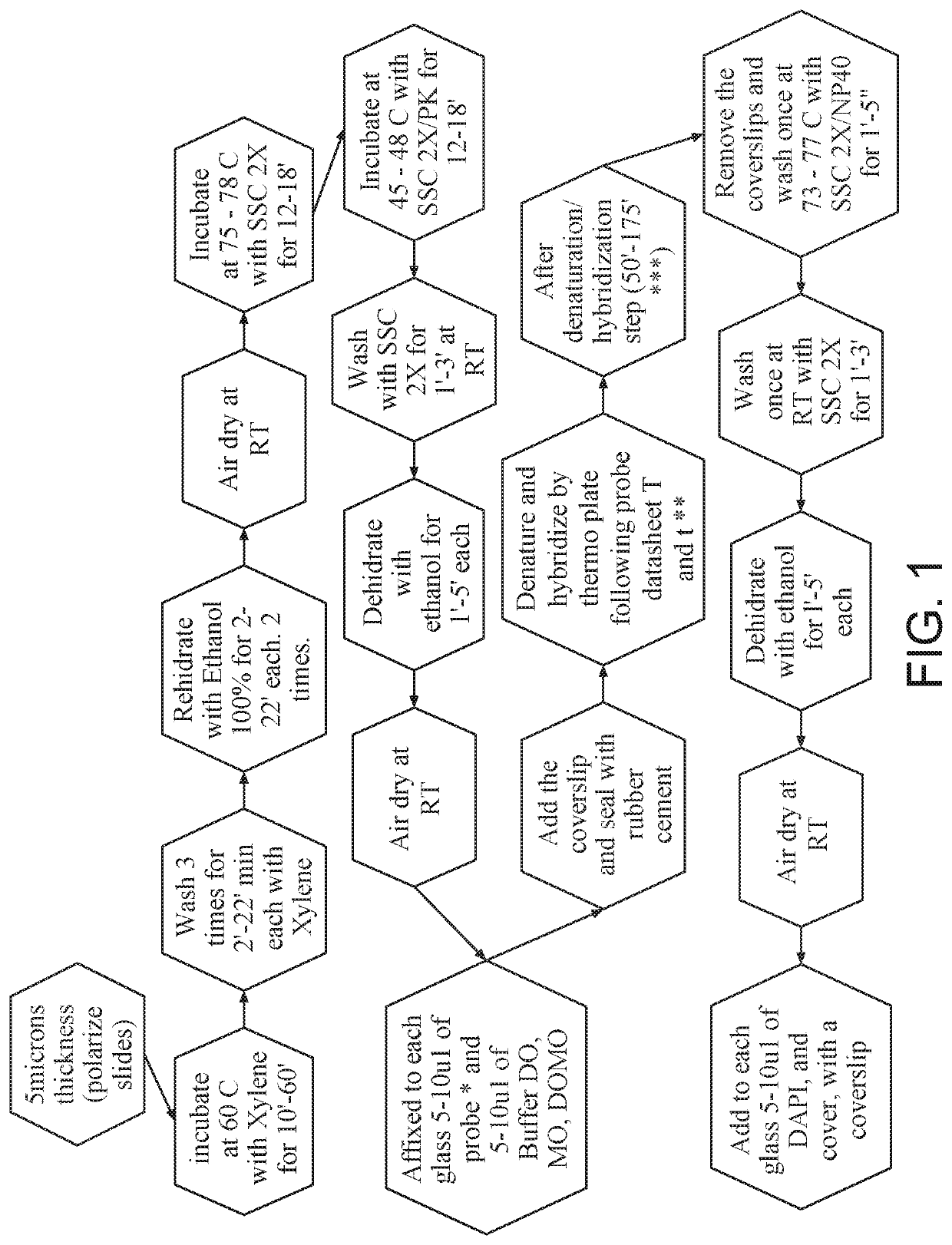Additive for accelerating hybridization
a hybridization and additive technology, applied in the field of molecular analysis techniques, can solve the problems of patient waiting for the analysis result, burden on the management of the analysis laboratory, and the limitations imposed by the limited number of molecular probes compatible with the system, so as to reduce the working time, reduce the cost, and the effect of reducing the tim
- Summary
- Abstract
- Description
- Claims
- Application Information
AI Technical Summary
Benefits of technology
Problems solved by technology
Method used
Image
Examples
example 1
edure on Histological and / or Cell-Block Samples
[0159]The sections of tissue (breast, lung, thyroid and brain) or FFPE cell-block material are cut to a thickness of 4-5 μm and placed under polarized slides.
[0160]They are then incubated in a drying oven for 30 minutes at 60° C. and deparaffinized for 30 min in xylol, also at 60° C.
[0161]The sections are then immersed in 3 successive washes of xylol at room temperature for 4 minutes each, under agitation.
[0162]Subsequently, the sections are air dried at room temperature and undergo 2 successive washes in 100% ethanol for 5 minutes each, under agitation.
[0163]The sections are then air dried at room temperature.
[0164]Once dried, the sections are transferred into the sodium citrate SSC2× buffer and heated to a temperature of 77° C. for the following times: breast and thyroid and relative neoplastic lesions 13 minutes, lung and relative neoplastic lesions 14 minutes, brain and relative neoplastic lesions 14 minutes.
[0165]The sections are t...
example 2
edure on Cytological Samples
[0176]The coverslip is removed from the previously stained cytological samples.
[0177]The samples then undergo 3 xylol washes of 20 minutes each.
[0178]The sections are then air dried at room temperature and undergo 2 successive washes in 100% ethanol for 5 minutes each, under agitation.
[0179]The slides are then immersed in SSC2× at room temperature for 2 minutes and incubated in SSC2× at 73° C. for 2 minutes.
[0180]An enzymatic treatment in 0.01N HCl / Pepsin 0.5 g is then performed at 37° C. for 30 minutes.
[0181]The samples are then incubated in a buffered neutral 1% formalin / MgCl2 solution for 5 minutes at room temperature.
[0182]The samples are then washed in SSC2× at room temperature for 2 minutes and dehydrated in progressively higher concentrations of alcohol (70%-85%-100%) for 2 minutes each.
[0183]They are then air dried at room temperature.
[0184]Once dried, attach to the sections 3-5 μl of a mix of specific probes (Her2 / CEP17; EGFR / CEP7; ALK-EML4; 1p36...
example 3
edure for Reprocessing (Both for Histological and FFPE Cell-Block Samples and for Cytological Samples)
[0192]This applies to the reprocessing of cases deemed to be “standard” due to histological and / or pre-analytical processing characteristics and / or to the reprocessing of cases deemed to be “difficult” due to histological and / or pre-analytical processing characteristics and / or inconclusive after an initial diagnosis using the standard method and / or all or part of that proposed in the present invention.
[0193]Remove the coverslip by immersing the samples in SSC2×1 at room temperature for 10 minutes, under agitation, dehydrate them by washing them in progressively higher concentrations of alcohol (70%-85%-100%) for 2 minutes each and air dry them at room temperature.
[0194]The sections are then immersed in 3 successive washes of xylol at room temperature for 10 minutes each, under agitation.
[0195]The sections are then air dried at room temperature and undergo 2 successive washes in 100%...
PUM
| Property | Measurement | Unit |
|---|---|---|
| dipole moment | aaaaa | aaaaa |
| temperature | aaaaa | aaaaa |
| temperature | aaaaa | aaaaa |
Abstract
Description
Claims
Application Information
 Login to View More
Login to View More - R&D
- Intellectual Property
- Life Sciences
- Materials
- Tech Scout
- Unparalleled Data Quality
- Higher Quality Content
- 60% Fewer Hallucinations
Browse by: Latest US Patents, China's latest patents, Technical Efficacy Thesaurus, Application Domain, Technology Topic, Popular Technical Reports.
© 2025 PatSnap. All rights reserved.Legal|Privacy policy|Modern Slavery Act Transparency Statement|Sitemap|About US| Contact US: help@patsnap.com

